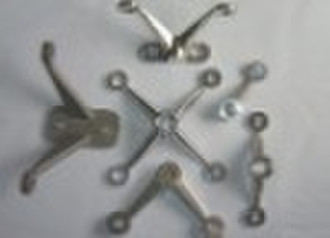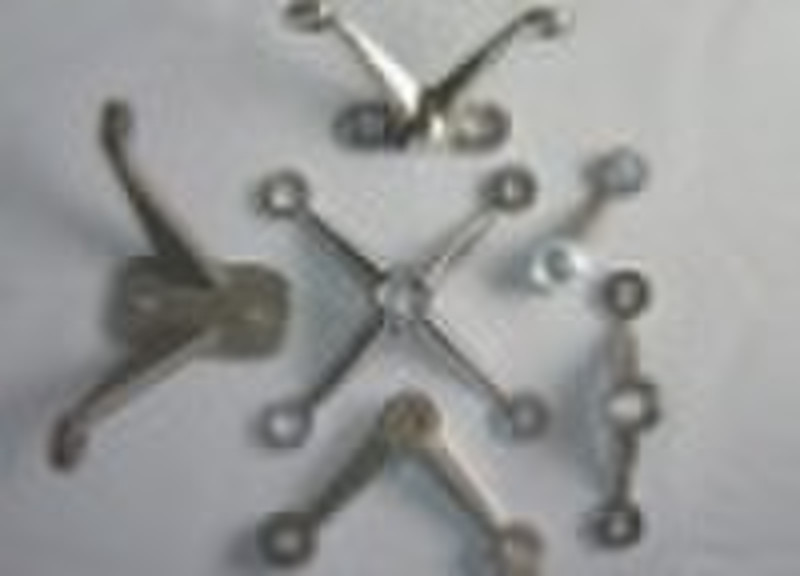Catalog
-
Catalog
- Agriculture
- Apparel
- Automobiles & Motorcycles
- Beauty & Personal Care
- Business Services
- Chemicals
- Construction & Real Estate
- Consumer Electronics
- Electrical Equipment & Supplies
- Electronic Components & Supplies
- Energy
- Environment
- Excess Inventory
- Fashion Accessories
- Food & Beverage
- Furniture
- Gifts & Crafts
- Hardware
- Health & Medical
- Home & Garden
- Home Appliances
- Lights & Lighting
- Luggage, Bags & Cases
- Machinery, Hardware & Tools
- Measurement & Analysis Instruments
- Mechanical Parts & Fabrication Services
- Minerals & Metallurgy
- Office & School Supplies
- Packaging & Printing
- Rubber & Plastics
- Security & Protection
- Service Equipment
- Shoes & Accessories
- Sports & Entertainment
- Telecommunications
- Textiles & Leather Products
- Timepieces, Jewelry, Eyewear
- Tools
- Toys & Hobbies
- Transportation
Filters
Search
investment casting
original price: 0,60 USD
Foshan, China
Production capacity:
10000 Piece / Month

Alex Chou
Contact person
Basic Information
| Material | Stainless steel |
|---|---|
| Place of Origin | Guangdong China (Mainland) |
| Brand Name | OEM offered |
| Model Number | Non-standard |
| Application | Glass wall curtain |
| Dimensions | Non-standard |
Investment castingWe offer stainless steel, carbon or alloy steel casting made by investment casting according to customer's design(OEM).Full service manufacturing of investment castings, including machining,heat treating, passivation, plating, polishing, painting and assembling.Material selectionAll castable materials can be processed using this method. Investment casting is particularly suitable for use with materials unsuited to machining. Surface qualityThe casting are produced without any trace of flash, and with an excellent surface finish.In many cases-expect for producing the required seat dimensions there is no need for a follow-on machining process.Piece weightsGenerally speaking,the investment casting technique is used for small piece weights of between1g and 10 kg. Larger work-pieces up to 150 kg are also possible.SummaryThe investment casting technique is characterized byAlmost unlimited scope for the shaping of castingsHardly any restrictions in terms of materialsA high degree of dimensional accuracy due to elimination of the mould parting line usually responsible forcasting imprecisionFacility for complex shaped inner contours due to the use of ceramic coresLow material allowance on surfacesto be machinedA high standard of surface qualityOur Precision Investment Casting Technology has been applied in theproduction of: Architectural Hardware Automotive and Off-road Vehicles Business Machines Construction Machinery Construction Tools Dairy Equipment Electrical Controls Food Service Equipment Machine Tools Machine Packaging Equipment Materials Handling Equipment Medical Equipment Pneumatic Fasteners Precision Optical Equipment Security Control Systems Sporting EquipmentTerms of delivery: 1. Definition and scope 1.1Investment casting is a process by which a high surface quality can be manufactured through the formation of dimensionally accurate casting.The patterns produced by injection moulding are heat disposable and are melted out after manufacture of the ceramic moulds. The ceramic moulds are destroyed after casting. For this reason, both the pattern and the moulds are designated lost using this method. Casting usually takes place into hot moulds. 1.2 Metals and nickel-based alloys can be used for investment casting.1.3This technical memorandum does not apply precious metals cast using the dewaxing method,to products of the jewellery industry,dental laboratories or toart casting. 2. Purpose 2.1This technical memorandum defines dimensional tolerances, specifies machining allowances and surface roughness corresponding to the start of the art in the field of investment casting. It serves as a basis for optimum economic cooperation between investment casting suppliers and buyers. 2.2The specifications mentioned here refer to sand blasted preserved or pickled surfaces in their delivered condition. Exception must be agreed where work processes are involved which alter the dimensional tolerances. 2.3Unless otherwise agreed,initial samples are supplied for first-time orders.These are used to permit concrete mutual agreement between supplier and purchaser.Initial samples must be appraised by the buyer,followed by awritten release to the foundry for series production.Deviation acknowledged by the releaseor with positive appraisal of the initial samples are binding for the production processand must be entered into the (casting) drawing. 3. Dimensional accuracy 3.1 Contraction and shrinkage During the solidification and cooling of cast metals, a contraction of the volume naturally occurs as aresult of shrinkage. Other factors influencing the production of instrument castingscan result fromthe shrinkage of the lost pattern and the expansion of moulds during heating. The sum of these influencing factors is taken into consideration in the shrinkage allowance during themanufacture of injection moulds. The shrinkage allowance is based on experience values,depending on the contour of the casting, the ceramic shell and the casting materials, as well as the casting techniques usedin the individual foundries. 3.2 Reference planes and reference points Drawing usedin the manufacture of casting must be gauged systematically using reference or locating points in order to ensure that dimensional checks and subsequentmachining are in agreement. Reference points must be determined right from the early design stage andcoordinated between the zero position of thereference planes is precisely defined by means of the reference point dimensions. All reference points must be arranged in such a way that theyare not removed or altered during the subsequent machining process.Reference points should be positioned on the out side surfaces of the investment casting.They may take the form of raised orreference points are beneficial when dealing with castings with restricted shape and position tolerances. When determining the reference points, attention should be paid to ensuring that they do not fall inthe area of asprue. In case of complex shaping,it is possible in this way to position the casting precisely by(pre-)machining the locating points. 3.3 Over definition According to DIN 406, overde finition must be avoided. Wall thicknesses must always be specified. 3.4 Mould and draught angles Mould and draught angles are not necessary as a general rule. Exceptions to this for reason of mould making or casting necessity must be agreed between the investment casting supplier and the buyer. 4. Dimensional tolerances 4.1 Linear dimensional tolerances Achievable dimensional tolerances on investment casting are dependent on the following factors: Casting material Dimensions and shape of the casting Validity of the accuracy grade 4.1.2. Dimensions and shape of the casting The achievable accuracy level of the rated dimensions of an investmentcasting depends on the greatest dimension and the shape of thecasting. If the rated dimension(GTA)exceeds the rated dimension range indicated for acertain accuracy level,the overall tolerance of the casting must be toleranced at the accuracy level (greatest tolerancefield). Deviation outside the accuracy level must be agreed between the supplier and the buyer. Note: The technical info above are incomplete. Please contact us for more information.
Delivery terms and packaging
Packaging Detail: Carton first, then placed into plywood cases. Or according to customer's requirements. Delivery Detail: Samples within 20-25 days, mass production within 30-35 days.
Port: Guang Zhou HuangPu
Payment term
Letter of credit
Telegraphic transfer
-
Payment Methods
We accept:









